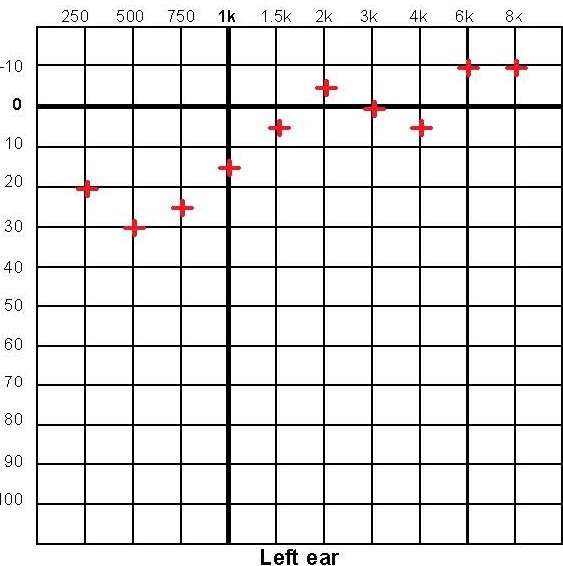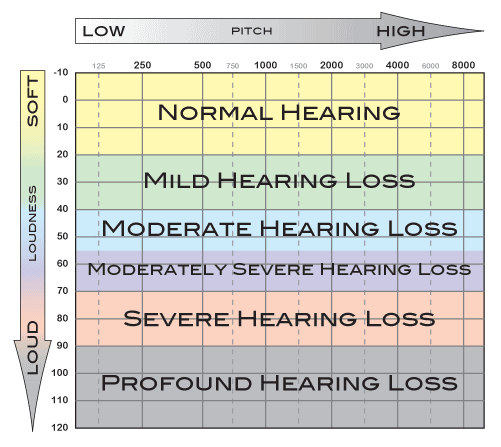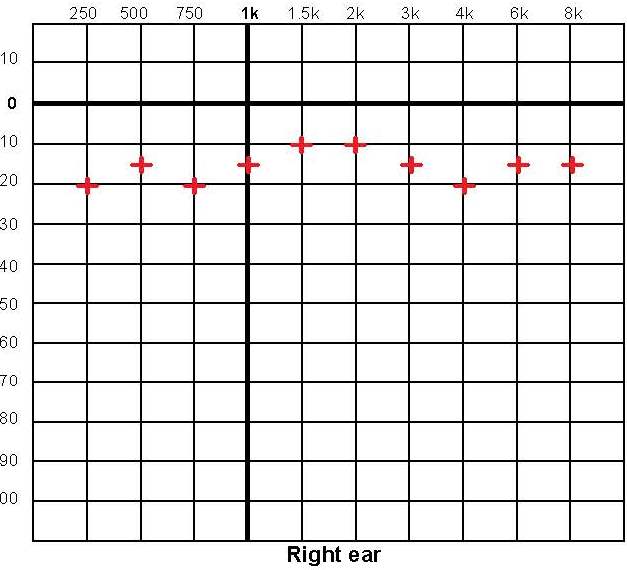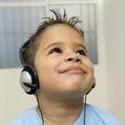|
| |
What Is An Audiogram?
What Is An
Audiogram?
An audiogram is a hearing tests that is usually
carried out in an environment which is soundproofed from external noise. It is
normally done by a licensed audiologist. The person whose hearing is being
tested listens to sounds transmitted by an audiologist and presses a button to
signal when they have heard something. The results of the test are plotted on an
audiogram. The person must be able to comply in order to have a reliable
audiogram.
An audiogram
graph shows the softest sounds a person can hear at different pitches or
frequencies.
In an audiogram
provided by an audiologist, an “O”
often is used to represent responses for the
right ear and an “X”
is used to represent responses for the
left ear. (see diagram below)
- Frequency or pitch is measured in
Hertz (Hz). Frequencies range from
low-pitch to high-pitch and read from left to right on the audiogram. Each
vertical line represents a different frequency. The frequencies tested in an
audiogram from an audiologist are usually these six (6) frequencies: 250,
500, 1000, 2000, 4000 and 8000 Hz.
-
The frequencies or pitches that have been used during a hearing test
above are
shown on the horizontal axis as the vertical lines. These frequencies are low on
the left side of the audiogram (250Hz), then gradually climb to higher
frequencies on the right side (8000 Hz or 8kHz). Humans can hear frequencies from
20
Hz up to 20,000 Hz, but an audiogram usually only shows a subset of our hearing range.
It focuses on the frequencies that are the most important for a clear
understanding of speech and for spoken words.
-
The
intensity is measured in decibels (dB). The intensity relates to how loud
or soft a sound is. Each horizontal line represents a different intensity level.
The softest sounds are at the top of the chart and the loudest sounds at the
bottom. Each mark on an individual’s hearing test would represent the softest
sounds they could hear. The softest intensity tested is typically 0 dB and the
loudest is 120 dB.
-
The volume or loudness that is required to reach a person's hearing threshold is shown
on the vertical axis as horizontal lines. These are expressed in deciBels
Hearing Level (dBHL). The dBHL are not absolute loudness levels but represent a
difference between your hearing and the average "normal" hearing. When scoring
0 dBHL, your hearing exactly matches the norm. Higher values are signs of
hearing
loss.
-
Normal hearing is defined by thresholds lower
than 15 dBHL at all frequencies, not strictly at 0 dBHL. The loudness scale goes
from very soft sounds on top (-10 dBHL) to loud sounds at the bottom (110 dBHL).
When doing a hearing test, markers will be set on the audiogram,and
will correspond to your personal hearing thresholds.
Levels of Hearing Loss Shown In
an Audiogram
-
Note: In terms AIT,
anything that is above 0 is considered to be a "hyperacute" frequency.
- Hearing loss
is classified in degrees of hearing from normal to a profound loss. This
classification is determined by the hearing threshold which is the softest a sound was
heard at a specific frequency.
About Listening Tests and
Audiograms That Done For Berard AIT
-
Audiograms for Berard AIT require that the Listening Test is done in
a different manner. Instead of the 6 frequencies, all 10
frequencies are tested.
-
If
the Listening Test is done by an audiologist who not accustomed to
Berard
AIT,
it is important that the audiologist tests all theses
ten (10) frequencies:
125Hz, 250Hz, 500Hz, 750Hz, 1000Hz, 1500Hz,
2000Hz, 3000Hz, 4000Hz, 6000Hz, 8000Hz
|
Note On Audiograms
Audiograms or
Listening Tests are NOT required to AIT to be
effective. We do not require testing for
children with autism, those age of 6 and under, or those who can't cooperative
to obtain a reliable
audiogram or Listening
Test results. Not all cases
who can do testing will require any additional filters to be for AIT to be successful.
The largest clinical study ever done on AIT
for children with autism with 445 participants in 1994 done by the Autism
Research Institute did not use listening test on this population.
Do not be
overly concerned if you are the parent of a child who is ineligible
to perform these tests because they have autism, are under the age of five OR because
they may have difficulty participating in the audio tests. The tests
may provide information resulting in a tangible benchmark
as to the effects of
Berard
AIT
-
but are not essential to its success! |
Example of a Berard AIT Listening Test
With Audio Graph - Left and Right Ears

| |
|










